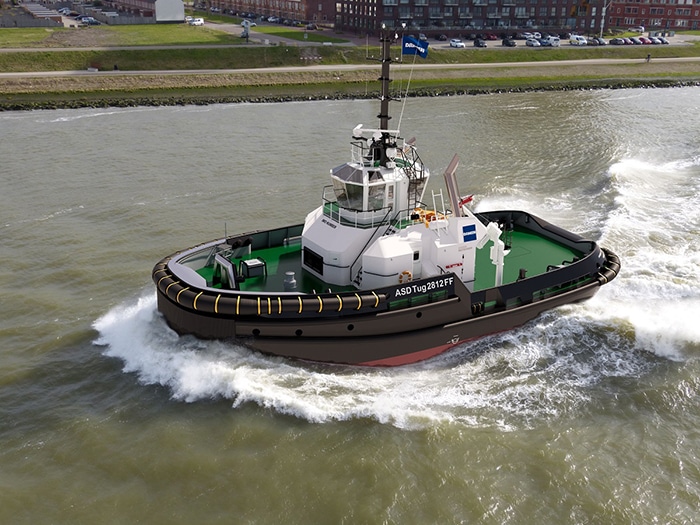With regulatory pressures mounting, operators of all types of vessels, including tugs, are assessing all the alternative fuel technology options. Releasing details of a new fuel flexible tug design, Damen, one of the world’s leading tug builders, says that the move towards a cleaner future is not only a challenge for vessel operators, but for shipbuilders too. They are faced with creating and constructing a platform that will be suited for operations in a future that remains far-off and unknown.
The big question is how to pay today for technology that will only provide a return on investment years into the future. It’s not the only question. What fuels will be available? What fuels will be affordable? Plus, in many cases, the technology required has not yet reached maturity even if someone were willing to invest in it.
Damen’s response has been the development of the Fuel Flexible Tug – the ASD Tug 2812 FF — a vessel prepared today, for whatever tomorrow may demand of it. Damen expects the first vessels to be in the water by 2026.
To achieve fuel flexibility Damen has adapted the tug’s design. To support less energy dense fuels, the vessel is required to be both heavier and larger. The tug, however, must remain compact, as required by the modern port operation. To ensure this, Damen is installing a very compact wheelhouse and reducing the beam. Beneath the waterline, the vessel will have volume enough to support the fuel preparation space and alternative tanks for fuels such as methanol – the first fuel that Damen is preparing for.
To overcome this, Damen set about forming a collaboration with Bureau Veritas (BV), as well as Belgian and Dutch flag state authorities and engine manufacturer Caterpillar. Together, the partners undertook a risk-based design process.
To achieve AiP, the solutions were required to be at least as safe as the originals. This required some out of the box thinking from the collaborators.
Among the risks Damen needed to consider was the low flashpoint of methanol at around 10° C, as opposed to the approximately 60° C of diesel – a temperature at which methanol begins to boil over. Plus, air mixed with methanol become explosive, creating a risk of toxicity, explosion or fire should there be an accumulation of vapors.
To avoid this, the rules require the positioning of a cofferdam between the methanol tanks and air to prevent methanol leakage and to prevent heating of the tanks – a solution not suitable for a space limited, compact tug.
Damen’s alternative was a full penetration welding solution on the methanol tanks to prevent leakage and the installation of methanol sensors in surrounding compartments. To prevent heating, A60 insulation is placed between the methanol tanks and air. Additionally, the tug is provided with combined tank-connection spaces/methanol-preparation spaces situated directly against the methanol tanks.
Additionally, the air ventilation required for methanol preparation spaces typically results in the establishment of permanent hazardous areas around the outlets – again not something that is feasible on a tug.
Here, Damen developed a solution in which closed spaces are filled with nitrogen. The replacement of oxygen with nitrogen mitigates explosion risk and avoids creation of permanent hazardous areas.
Another requirement of current rules is venting to allow release of overpressure that may occur. Again, this requires the creation of permanent hazardous areas. Here, Damen came up with the solution of storage tanks able to handle all likely pressure fluctuations that can occur during normal operation. As a result, there is no unexpected emergency release of toxic, flammable vapours and, therefore, no permanent hazardous zones.
Each of these solutions has been awarded an AiP from BV, and each has a patent pending.
Tags: Damen, Flexible Tug, Fuel



Recent Posts
Wärtsilä to Power USA’s First All-Electric High-Speed Ferries in San Francisco Bay
ABS and Pusan National University Chart a Course for Liquid Hydrogen Shipping
RIC Energy and Siemens Partner to Advance Green Hydrogen and E-Fuels Projects in Spain
Moeve to Supply 40,000 Tons of 2G Marine Biofuel to Grupo Armas Trasmediterránea in Canary Islands
Smart Green Shipping Completes Successful Sea Trials of Wind-Assisted Propulsion System
CMA CGM Unveils Vietnam’s First Fully Electric River Barge in Collaboration with NIKE
Vietnam and France Join Forces to Explore Green Hydrogen for Remote Islands
Port of Rotterdam Tests Electric Hydrofoil Vessel in Push for Sustainable Operations